Estimating Report: Construction Industry Cost Estimation and Tendering
VerifiedAdded on 2023/06/03
|11
|2780
|372
Report
AI Summary
This report delves into the intricacies of construction estimating, examining the role of ASMM5/6 in preparing Bills of Quantity, its relevance to industry professionals, and the assumptions involved in its application. It differentiates between elemental and trade cost management tools, analyzing their influence on rates and suitability for project proposals. The report then explores the general approach to the tender process, including invitation, clarification, submission, variant bids, qualified tenders, settlement, and contract execution. It also provides strategies for determining the right tender price, considering factors such as time, cost, and profitability, and highlights key considerations before undertaking a project. Finally, it assesses the impact of increasing construction costs and other economic factors on the industry's growth, referencing relevant articles and providing an overview of the current market landscape and future projections.
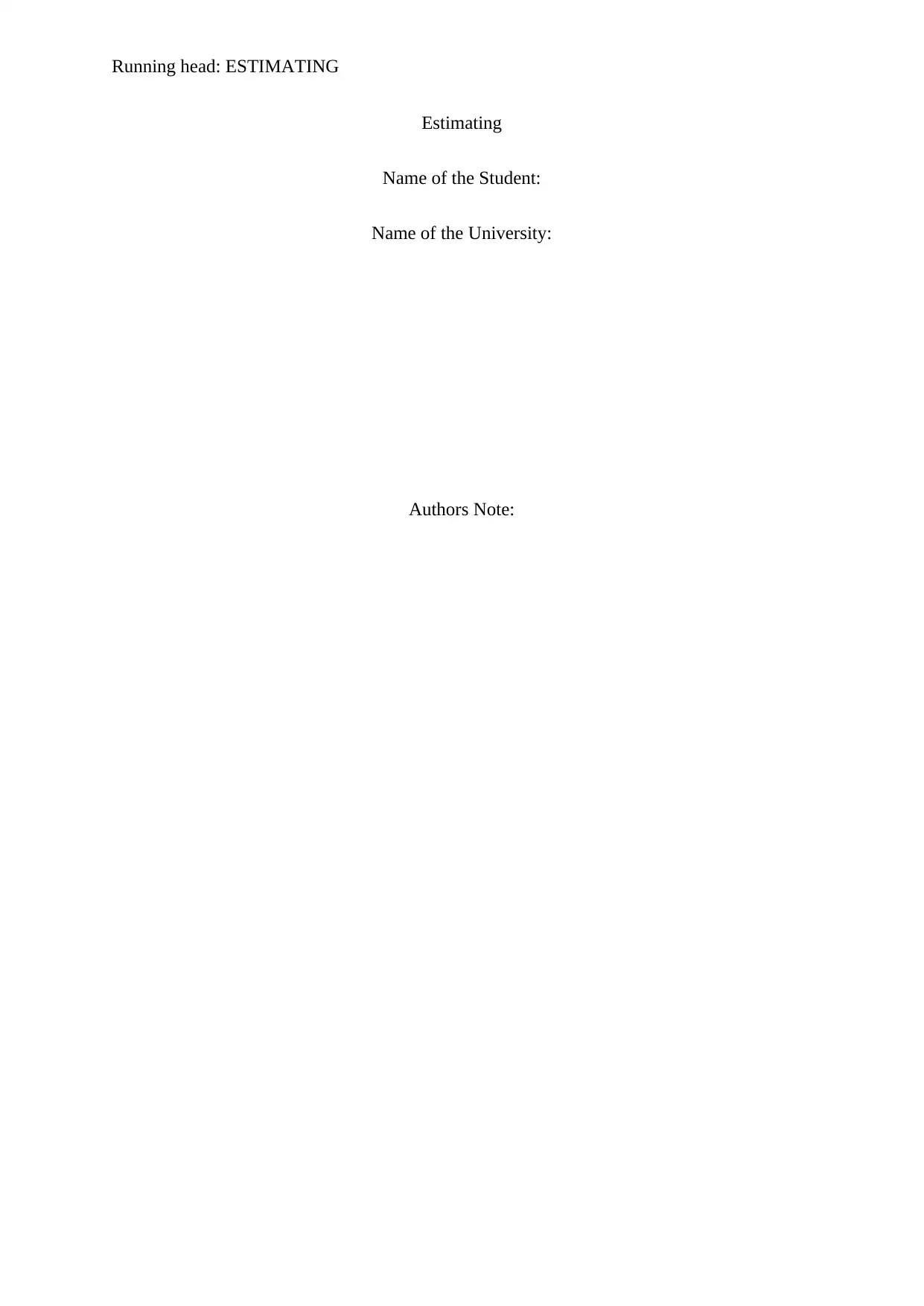
Running head: ESTIMATING
Estimating
Name of the Student:
Name of the University:
Authors Note:
Estimating
Name of the Student:
Name of the University:
Authors Note:
Paraphrase This Document
Need a fresh take? Get an instant paraphrase of this document with our AI Paraphraser
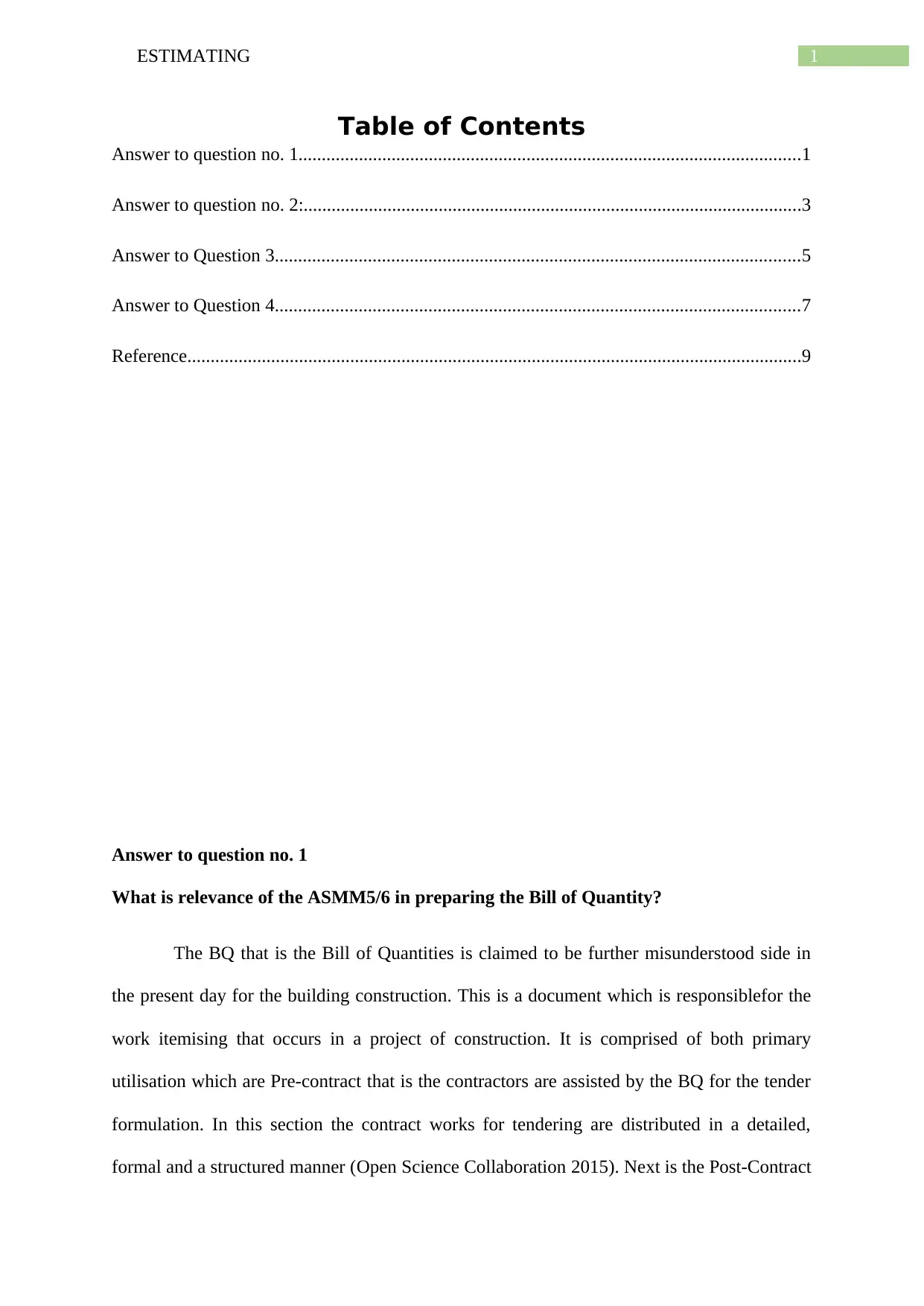
1ESTIMATING
Table of Contents
Answer to question no. 1............................................................................................................1
Answer to question no. 2:...........................................................................................................3
Answer to Question 3.................................................................................................................5
Answer to Question 4.................................................................................................................7
Reference....................................................................................................................................9
Answer to question no. 1
What is relevance of the ASMM5/6 in preparing the Bill of Quantity?
The BQ that is the Bill of Quantities is claimed to be further misunderstood side in
the present day for the building construction. This is a document which is responsiblefor the
work itemising that occurs in a project of construction. It is comprised of both primary
utilisation which are Pre-contract that is the contractors are assisted by the BQ for the tender
formulation. In this section the contract works for tendering are distributed in a detailed,
formal and a structured manner (Open Science Collaboration 2015). Next is the Post-Contract
Table of Contents
Answer to question no. 1............................................................................................................1
Answer to question no. 2:...........................................................................................................3
Answer to Question 3.................................................................................................................5
Answer to Question 4.................................................................................................................7
Reference....................................................................................................................................9
Answer to question no. 1
What is relevance of the ASMM5/6 in preparing the Bill of Quantity?
The BQ that is the Bill of Quantities is claimed to be further misunderstood side in
the present day for the building construction. This is a document which is responsiblefor the
work itemising that occurs in a project of construction. It is comprised of both primary
utilisation which are Pre-contract that is the contractors are assisted by the BQ for the tender
formulation. In this section the contract works for tendering are distributed in a detailed,
formal and a structured manner (Open Science Collaboration 2015). Next is the Post-Contract
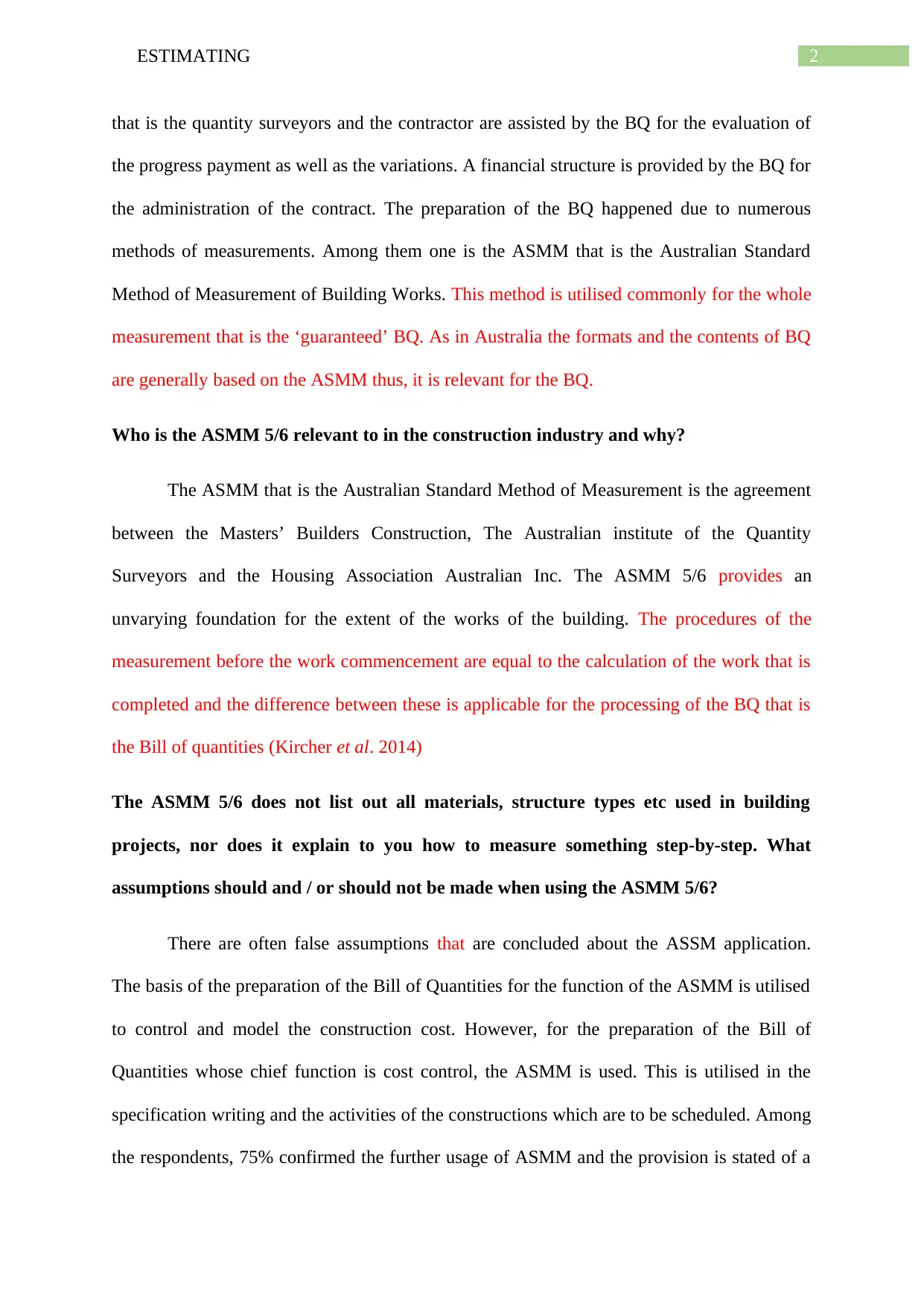
2ESTIMATING
that is the quantity surveyors and the contractor are assisted by the BQ for the evaluation of
the progress payment as well as the variations. A financial structure is provided by the BQ for
the administration of the contract. The preparation of the BQ happened due to numerous
methods of measurements. Among them one is the ASMM that is the Australian Standard
Method of Measurement of Building Works. This method is utilised commonly for the whole
measurement that is the ‘guaranteed’ BQ. As in Australia the formats and the contents of BQ
are generally based on the ASMM thus, it is relevant for the BQ.
Who is the ASMM 5/6 relevant to in the construction industry and why?
The ASMM that is the Australian Standard Method of Measurement is the agreement
between the Masters’ Builders Construction, The Australian institute of the Quantity
Surveyors and the Housing Association Australian Inc. The ASMM 5/6 provides an
unvarying foundation for the extent of the works of the building. The procedures of the
measurement before the work commencement are equal to the calculation of the work that is
completed and the difference between these is applicable for the processing of the BQ that is
the Bill of quantities (Kircher et al. 2014)
The ASMM 5/6 does not list out all materials, structure types etc used in building
projects, nor does it explain to you how to measure something step-by-step. What
assumptions should and / or should not be made when using the ASMM 5/6?
There are often false assumptions that are concluded about the ASSM application.
The basis of the preparation of the Bill of Quantities for the function of the ASMM is utilised
to control and model the construction cost. However, for the preparation of the Bill of
Quantities whose chief function is cost control, the ASMM is used. This is utilised in the
specification writing and the activities of the constructions which are to be scheduled. Among
the respondents, 75% confirmed the further usage of ASMM and the provision is stated of a
that is the quantity surveyors and the contractor are assisted by the BQ for the evaluation of
the progress payment as well as the variations. A financial structure is provided by the BQ for
the administration of the contract. The preparation of the BQ happened due to numerous
methods of measurements. Among them one is the ASMM that is the Australian Standard
Method of Measurement of Building Works. This method is utilised commonly for the whole
measurement that is the ‘guaranteed’ BQ. As in Australia the formats and the contents of BQ
are generally based on the ASMM thus, it is relevant for the BQ.
Who is the ASMM 5/6 relevant to in the construction industry and why?
The ASMM that is the Australian Standard Method of Measurement is the agreement
between the Masters’ Builders Construction, The Australian institute of the Quantity
Surveyors and the Housing Association Australian Inc. The ASMM 5/6 provides an
unvarying foundation for the extent of the works of the building. The procedures of the
measurement before the work commencement are equal to the calculation of the work that is
completed and the difference between these is applicable for the processing of the BQ that is
the Bill of quantities (Kircher et al. 2014)
The ASMM 5/6 does not list out all materials, structure types etc used in building
projects, nor does it explain to you how to measure something step-by-step. What
assumptions should and / or should not be made when using the ASMM 5/6?
There are often false assumptions that are concluded about the ASSM application.
The basis of the preparation of the Bill of Quantities for the function of the ASMM is utilised
to control and model the construction cost. However, for the preparation of the Bill of
Quantities whose chief function is cost control, the ASMM is used. This is utilised in the
specification writing and the activities of the constructions which are to be scheduled. Among
the respondents, 75% confirmed the further usage of ASMM and the provision is stated of a
⊘ This is a preview!⊘
Do you want full access?
Subscribe today to unlock all pages.

Trusted by 1+ million students worldwide
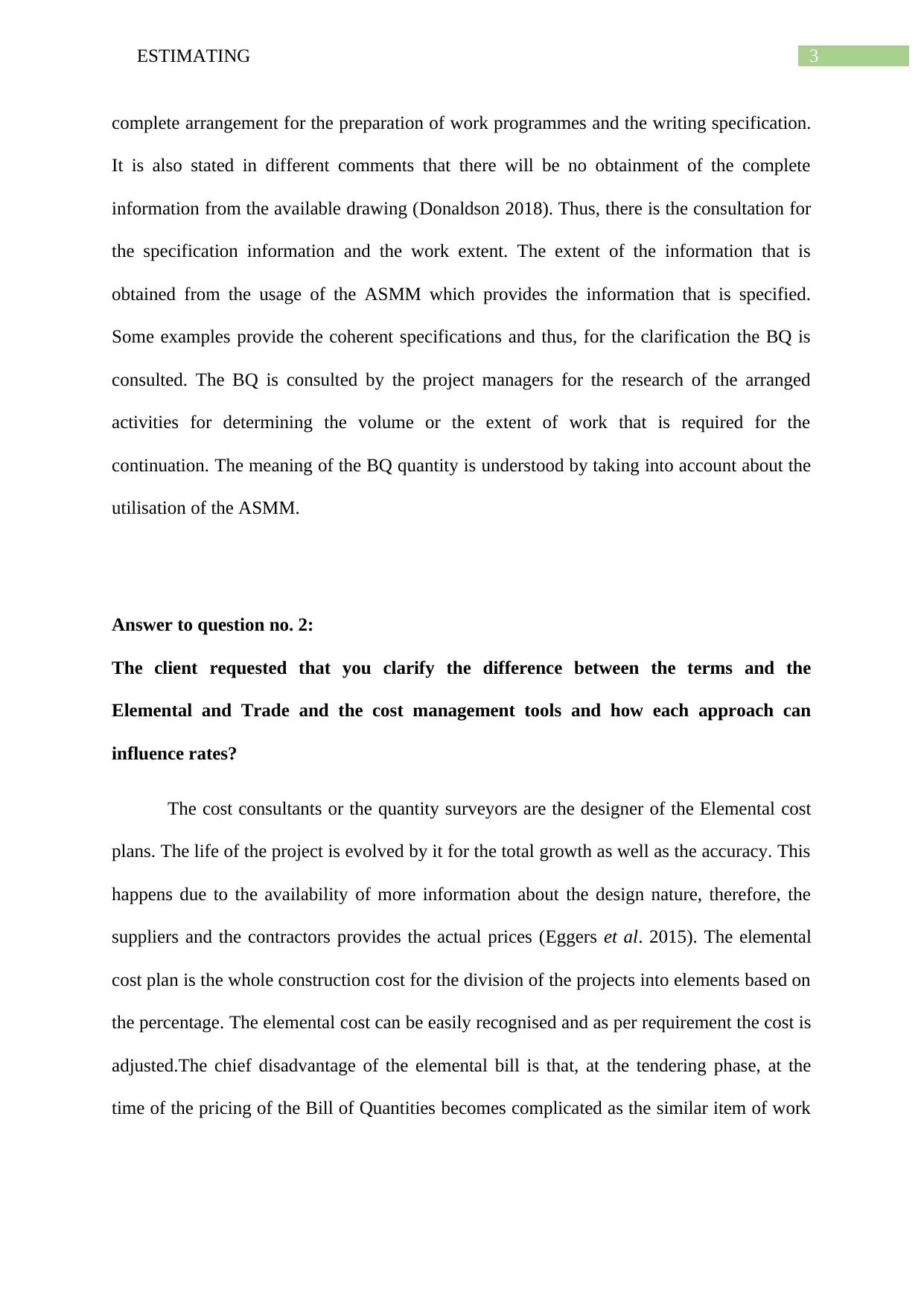
3ESTIMATING
complete arrangement for the preparation of work programmes and the writing specification.
It is also stated in different comments that there will be no obtainment of the complete
information from the available drawing (Donaldson 2018). Thus, there is the consultation for
the specification information and the work extent. The extent of the information that is
obtained from the usage of the ASMM which provides the information that is specified.
Some examples provide the coherent specifications and thus, for the clarification the BQ is
consulted. The BQ is consulted by the project managers for the research of the arranged
activities for determining the volume or the extent of work that is required for the
continuation. The meaning of the BQ quantity is understood by taking into account about the
utilisation of the ASMM.
Answer to question no. 2:
The client requested that you clarify the difference between the terms and the
Elemental and Trade and the cost management tools and how each approach can
influence rates?
The cost consultants or the quantity surveyors are the designer of the Elemental cost
plans. The life of the project is evolved by it for the total growth as well as the accuracy. This
happens due to the availability of more information about the design nature, therefore, the
suppliers and the contractors provides the actual prices (Eggers et al. 2015). The elemental
cost plan is the whole construction cost for the division of the projects into elements based on
the percentage. The elemental cost can be easily recognised and as per requirement the cost is
adjusted.The chief disadvantage of the elemental bill is that, at the tendering phase, at the
time of the pricing of the Bill of Quantities becomes complicated as the similar item of work
complete arrangement for the preparation of work programmes and the writing specification.
It is also stated in different comments that there will be no obtainment of the complete
information from the available drawing (Donaldson 2018). Thus, there is the consultation for
the specification information and the work extent. The extent of the information that is
obtained from the usage of the ASMM which provides the information that is specified.
Some examples provide the coherent specifications and thus, for the clarification the BQ is
consulted. The BQ is consulted by the project managers for the research of the arranged
activities for determining the volume or the extent of work that is required for the
continuation. The meaning of the BQ quantity is understood by taking into account about the
utilisation of the ASMM.
Answer to question no. 2:
The client requested that you clarify the difference between the terms and the
Elemental and Trade and the cost management tools and how each approach can
influence rates?
The cost consultants or the quantity surveyors are the designer of the Elemental cost
plans. The life of the project is evolved by it for the total growth as well as the accuracy. This
happens due to the availability of more information about the design nature, therefore, the
suppliers and the contractors provides the actual prices (Eggers et al. 2015). The elemental
cost plan is the whole construction cost for the division of the projects into elements based on
the percentage. The elemental cost can be easily recognised and as per requirement the cost is
adjusted.The chief disadvantage of the elemental bill is that, at the tendering phase, at the
time of the pricing of the Bill of Quantities becomes complicated as the similar item of work
Paraphrase This Document
Need a fresh take? Get an instant paraphrase of this document with our AI Paraphraser
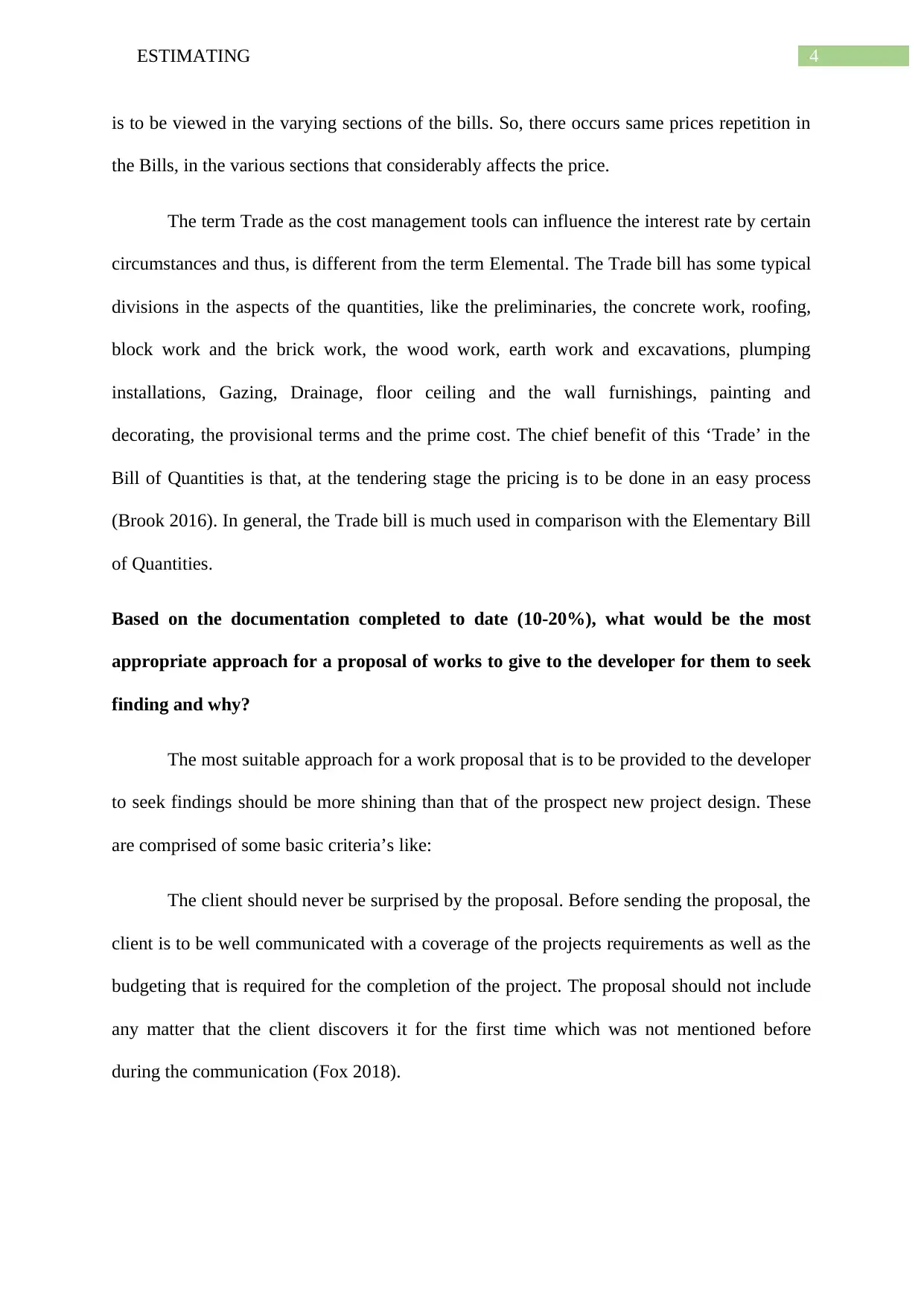
4ESTIMATING
is to be viewed in the varying sections of the bills. So, there occurs same prices repetition in
the Bills, in the various sections that considerably affects the price.
The term Trade as the cost management tools can influence the interest rate by certain
circumstances and thus, is different from the term Elemental. The Trade bill has some typical
divisions in the aspects of the quantities, like the preliminaries, the concrete work, roofing,
block work and the brick work, the wood work, earth work and excavations, plumping
installations, Gazing, Drainage, floor ceiling and the wall furnishings, painting and
decorating, the provisional terms and the prime cost. The chief benefit of this ‘Trade’ in the
Bill of Quantities is that, at the tendering stage the pricing is to be done in an easy process
(Brook 2016). In general, the Trade bill is much used in comparison with the Elementary Bill
of Quantities.
Based on the documentation completed to date (10-20%), what would be the most
appropriate approach for a proposal of works to give to the developer for them to seek
finding and why?
The most suitable approach for a work proposal that is to be provided to the developer
to seek findings should be more shining than that of the prospect new project design. These
are comprised of some basic criteria’s like:
The client should never be surprised by the proposal. Before sending the proposal, the
client is to be well communicated with a coverage of the projects requirements as well as the
budgeting that is required for the completion of the project. The proposal should not include
any matter that the client discovers it for the first time which was not mentioned before
during the communication (Fox 2018).
is to be viewed in the varying sections of the bills. So, there occurs same prices repetition in
the Bills, in the various sections that considerably affects the price.
The term Trade as the cost management tools can influence the interest rate by certain
circumstances and thus, is different from the term Elemental. The Trade bill has some typical
divisions in the aspects of the quantities, like the preliminaries, the concrete work, roofing,
block work and the brick work, the wood work, earth work and excavations, plumping
installations, Gazing, Drainage, floor ceiling and the wall furnishings, painting and
decorating, the provisional terms and the prime cost. The chief benefit of this ‘Trade’ in the
Bill of Quantities is that, at the tendering stage the pricing is to be done in an easy process
(Brook 2016). In general, the Trade bill is much used in comparison with the Elementary Bill
of Quantities.
Based on the documentation completed to date (10-20%), what would be the most
appropriate approach for a proposal of works to give to the developer for them to seek
finding and why?
The most suitable approach for a work proposal that is to be provided to the developer
to seek findings should be more shining than that of the prospect new project design. These
are comprised of some basic criteria’s like:
The client should never be surprised by the proposal. Before sending the proposal, the
client is to be well communicated with a coverage of the projects requirements as well as the
budgeting that is required for the completion of the project. The proposal should not include
any matter that the client discovers it for the first time which was not mentioned before
during the communication (Fox 2018).
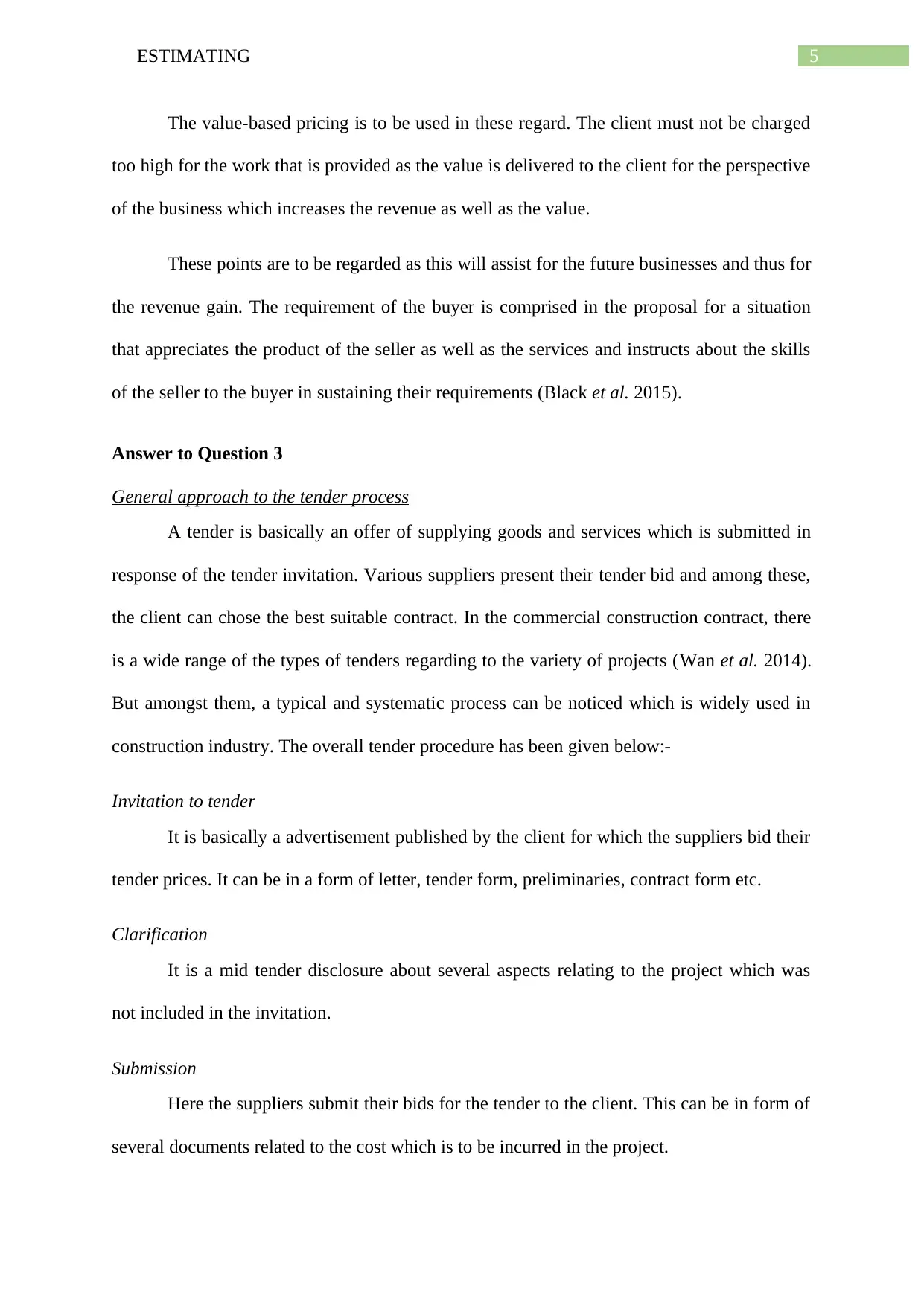
5ESTIMATING
The value-based pricing is to be used in these regard. The client must not be charged
too high for the work that is provided as the value is delivered to the client for the perspective
of the business which increases the revenue as well as the value.
These points are to be regarded as this will assist for the future businesses and thus for
the revenue gain. The requirement of the buyer is comprised in the proposal for a situation
that appreciates the product of the seller as well as the services and instructs about the skills
of the seller to the buyer in sustaining their requirements (Black et al. 2015).
Answer to Question 3
General approach to the tender process
A tender is basically an offer of supplying goods and services which is submitted in
response of the tender invitation. Various suppliers present their tender bid and among these,
the client can chose the best suitable contract. In the commercial construction contract, there
is a wide range of the types of tenders regarding to the variety of projects (Wan et al. 2014).
But amongst them, a typical and systematic process can be noticed which is widely used in
construction industry. The overall tender procedure has been given below:-
Invitation to tender
It is basically a advertisement published by the client for which the suppliers bid their
tender prices. It can be in a form of letter, tender form, preliminaries, contract form etc.
Clarification
It is a mid tender disclosure about several aspects relating to the project which was
not included in the invitation.
Submission
Here the suppliers submit their bids for the tender to the client. This can be in form of
several documents related to the cost which is to be incurred in the project.
The value-based pricing is to be used in these regard. The client must not be charged
too high for the work that is provided as the value is delivered to the client for the perspective
of the business which increases the revenue as well as the value.
These points are to be regarded as this will assist for the future businesses and thus for
the revenue gain. The requirement of the buyer is comprised in the proposal for a situation
that appreciates the product of the seller as well as the services and instructs about the skills
of the seller to the buyer in sustaining their requirements (Black et al. 2015).
Answer to Question 3
General approach to the tender process
A tender is basically an offer of supplying goods and services which is submitted in
response of the tender invitation. Various suppliers present their tender bid and among these,
the client can chose the best suitable contract. In the commercial construction contract, there
is a wide range of the types of tenders regarding to the variety of projects (Wan et al. 2014).
But amongst them, a typical and systematic process can be noticed which is widely used in
construction industry. The overall tender procedure has been given below:-
Invitation to tender
It is basically a advertisement published by the client for which the suppliers bid their
tender prices. It can be in a form of letter, tender form, preliminaries, contract form etc.
Clarification
It is a mid tender disclosure about several aspects relating to the project which was
not included in the invitation.
Submission
Here the suppliers submit their bids for the tender to the client. This can be in form of
several documents related to the cost which is to be incurred in the project.
⊘ This is a preview!⊘
Do you want full access?
Subscribe today to unlock all pages.

Trusted by 1+ million students worldwide
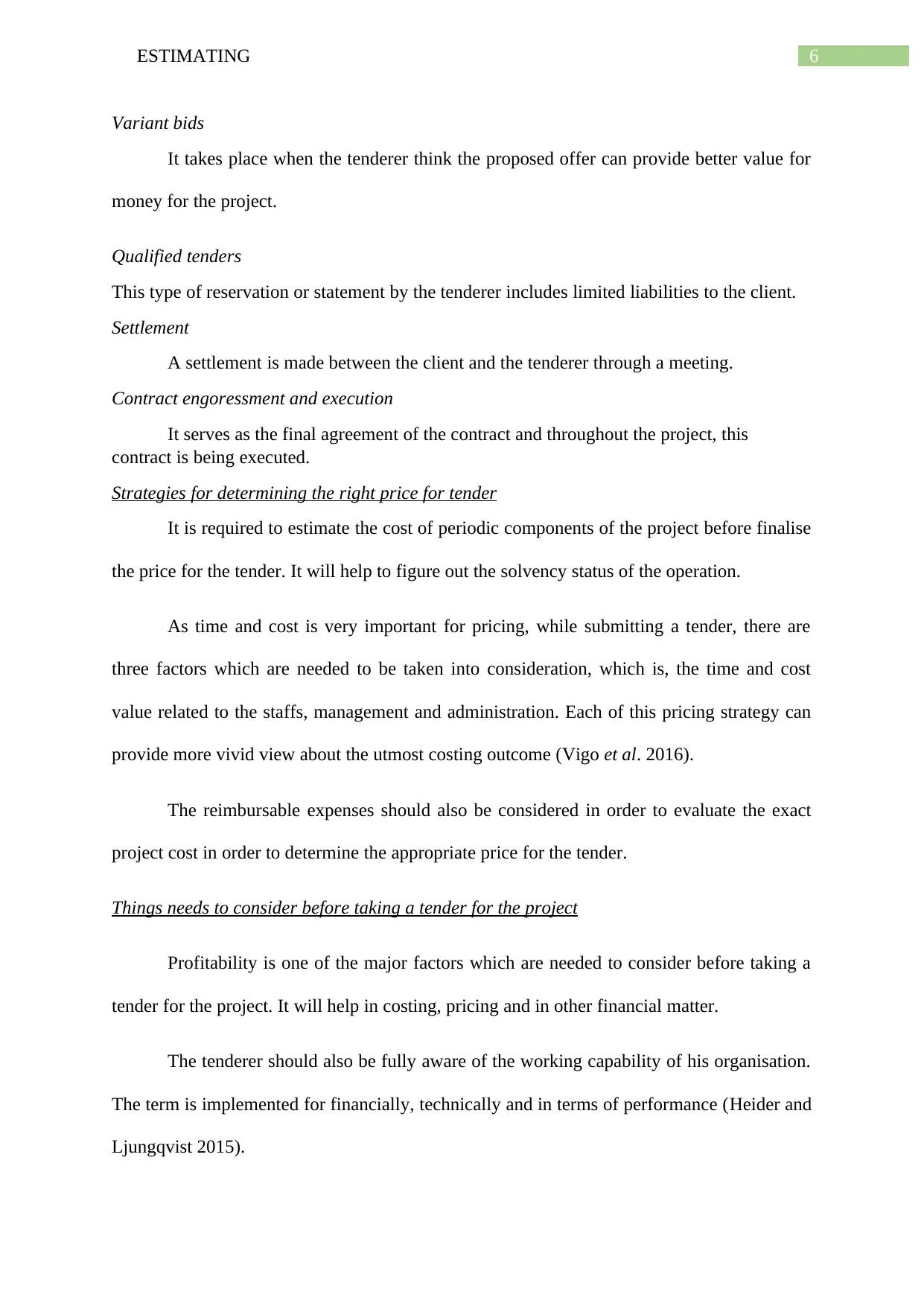
6ESTIMATING
Variant bids
It takes place when the tenderer think the proposed offer can provide better value for
money for the project.
Qualified tenders
This type of reservation or statement by the tenderer includes limited liabilities to the client.
Settlement
A settlement is made between the client and the tenderer through a meeting.
Contract engoressment and execution
It serves as the final agreement of the contract and throughout the project, this
contract is being executed.
Strategies for determining the right price for tender
It is required to estimate the cost of periodic components of the project before finalise
the price for the tender. It will help to figure out the solvency status of the operation.
As time and cost is very important for pricing, while submitting a tender, there are
three factors which are needed to be taken into consideration, which is, the time and cost
value related to the staffs, management and administration. Each of this pricing strategy can
provide more vivid view about the utmost costing outcome (Vigo et al. 2016).
The reimbursable expenses should also be considered in order to evaluate the exact
project cost in order to determine the appropriate price for the tender.
Things needs to consider before taking a tender for the project
Profitability is one of the major factors which are needed to consider before taking a
tender for the project. It will help in costing, pricing and in other financial matter.
The tenderer should also be fully aware of the working capability of his organisation.
The term is implemented for financially, technically and in terms of performance (Heider and
Ljungqvist 2015).
Variant bids
It takes place when the tenderer think the proposed offer can provide better value for
money for the project.
Qualified tenders
This type of reservation or statement by the tenderer includes limited liabilities to the client.
Settlement
A settlement is made between the client and the tenderer through a meeting.
Contract engoressment and execution
It serves as the final agreement of the contract and throughout the project, this
contract is being executed.
Strategies for determining the right price for tender
It is required to estimate the cost of periodic components of the project before finalise
the price for the tender. It will help to figure out the solvency status of the operation.
As time and cost is very important for pricing, while submitting a tender, there are
three factors which are needed to be taken into consideration, which is, the time and cost
value related to the staffs, management and administration. Each of this pricing strategy can
provide more vivid view about the utmost costing outcome (Vigo et al. 2016).
The reimbursable expenses should also be considered in order to evaluate the exact
project cost in order to determine the appropriate price for the tender.
Things needs to consider before taking a tender for the project
Profitability is one of the major factors which are needed to consider before taking a
tender for the project. It will help in costing, pricing and in other financial matter.
The tenderer should also be fully aware of the working capability of his organisation.
The term is implemented for financially, technically and in terms of performance (Heider and
Ljungqvist 2015).
Paraphrase This Document
Need a fresh take? Get an instant paraphrase of this document with our AI Paraphraser
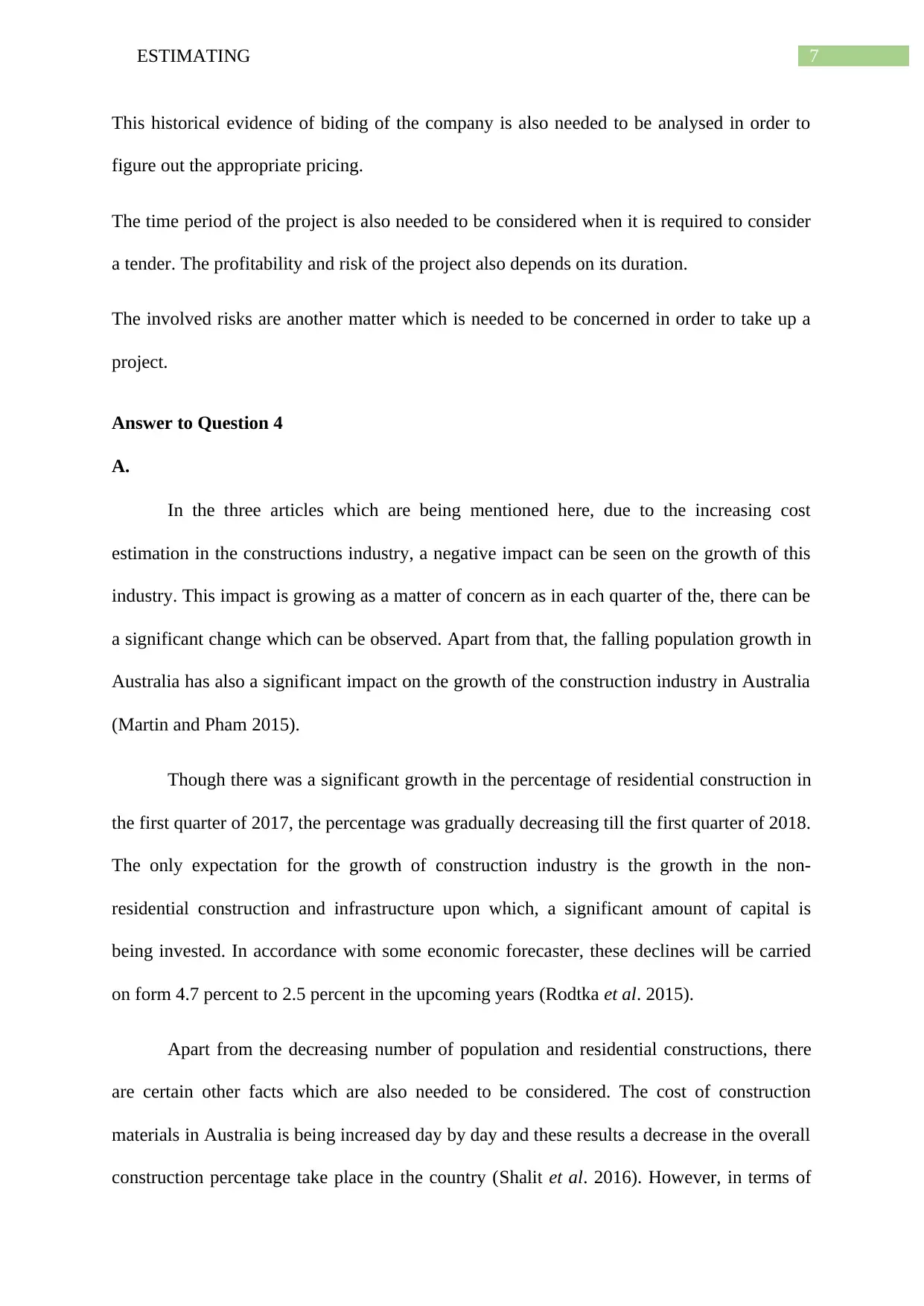
7ESTIMATING
This historical evidence of biding of the company is also needed to be analysed in order to
figure out the appropriate pricing.
The time period of the project is also needed to be considered when it is required to consider
a tender. The profitability and risk of the project also depends on its duration.
The involved risks are another matter which is needed to be concerned in order to take up a
project.
Answer to Question 4
A.
In the three articles which are being mentioned here, due to the increasing cost
estimation in the constructions industry, a negative impact can be seen on the growth of this
industry. This impact is growing as a matter of concern as in each quarter of the, there can be
a significant change which can be observed. Apart from that, the falling population growth in
Australia has also a significant impact on the growth of the construction industry in Australia
(Martin and Pham 2015).
Though there was a significant growth in the percentage of residential construction in
the first quarter of 2017, the percentage was gradually decreasing till the first quarter of 2018.
The only expectation for the growth of construction industry is the growth in the non-
residential construction and infrastructure upon which, a significant amount of capital is
being invested. In accordance with some economic forecaster, these declines will be carried
on form 4.7 percent to 2.5 percent in the upcoming years (Rodtka et al. 2015).
Apart from the decreasing number of population and residential constructions, there
are certain other facts which are also needed to be considered. The cost of construction
materials in Australia is being increased day by day and these results a decrease in the overall
construction percentage take place in the country (Shalit et al. 2016). However, in terms of
This historical evidence of biding of the company is also needed to be analysed in order to
figure out the appropriate pricing.
The time period of the project is also needed to be considered when it is required to consider
a tender. The profitability and risk of the project also depends on its duration.
The involved risks are another matter which is needed to be concerned in order to take up a
project.
Answer to Question 4
A.
In the three articles which are being mentioned here, due to the increasing cost
estimation in the constructions industry, a negative impact can be seen on the growth of this
industry. This impact is growing as a matter of concern as in each quarter of the, there can be
a significant change which can be observed. Apart from that, the falling population growth in
Australia has also a significant impact on the growth of the construction industry in Australia
(Martin and Pham 2015).
Though there was a significant growth in the percentage of residential construction in
the first quarter of 2017, the percentage was gradually decreasing till the first quarter of 2018.
The only expectation for the growth of construction industry is the growth in the non-
residential construction and infrastructure upon which, a significant amount of capital is
being invested. In accordance with some economic forecaster, these declines will be carried
on form 4.7 percent to 2.5 percent in the upcoming years (Rodtka et al. 2015).
Apart from the decreasing number of population and residential constructions, there
are certain other facts which are also needed to be considered. The cost of construction
materials in Australia is being increased day by day and these results a decrease in the overall
construction percentage take place in the country (Shalit et al. 2016). However, in terms of
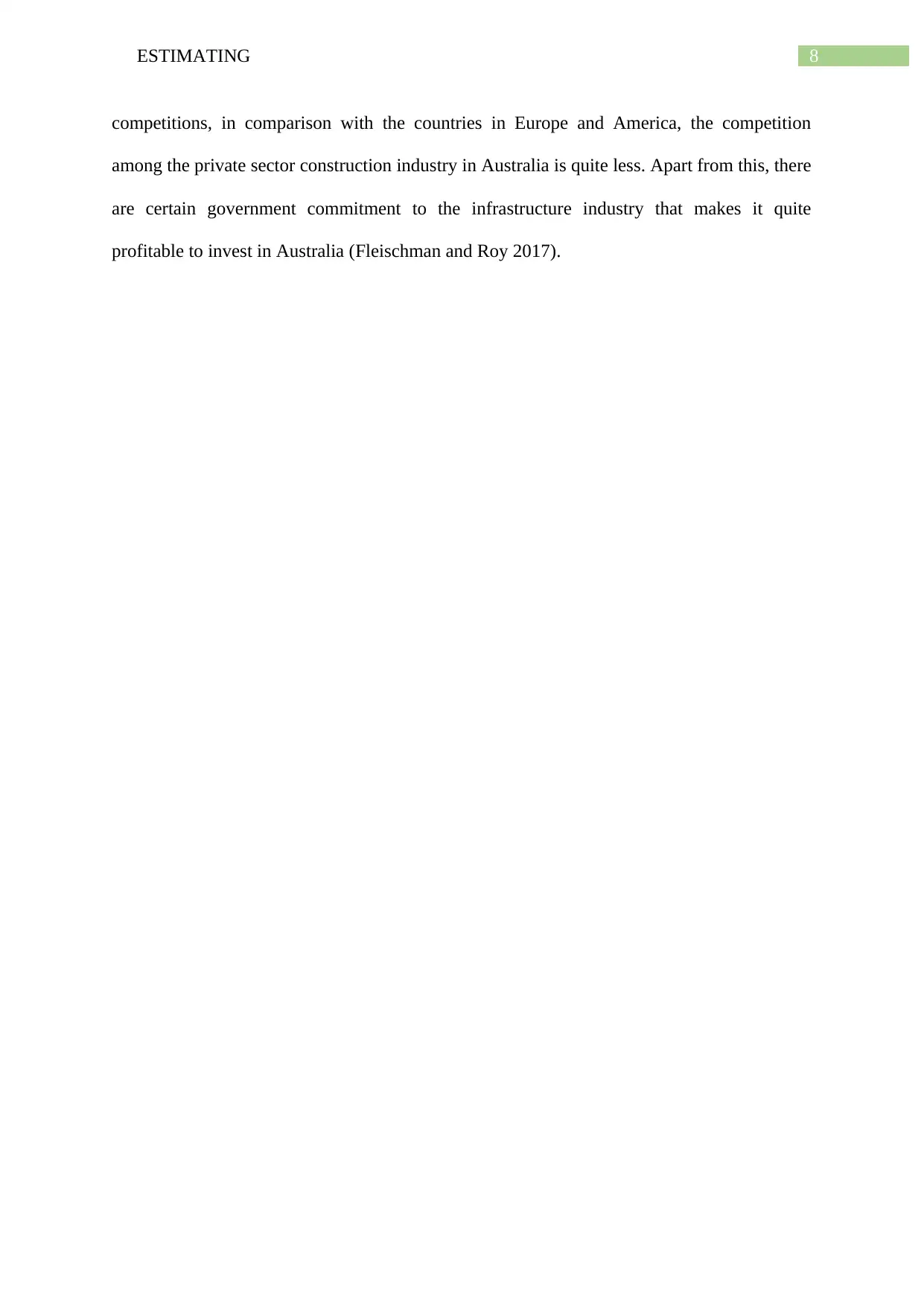
8ESTIMATING
competitions, in comparison with the countries in Europe and America, the competition
among the private sector construction industry in Australia is quite less. Apart from this, there
are certain government commitment to the infrastructure industry that makes it quite
profitable to invest in Australia (Fleischman and Roy 2017).
competitions, in comparison with the countries in Europe and America, the competition
among the private sector construction industry in Australia is quite less. Apart from this, there
are certain government commitment to the infrastructure industry that makes it quite
profitable to invest in Australia (Fleischman and Roy 2017).
⊘ This is a preview!⊘
Do you want full access?
Subscribe today to unlock all pages.

Trusted by 1+ million students worldwide
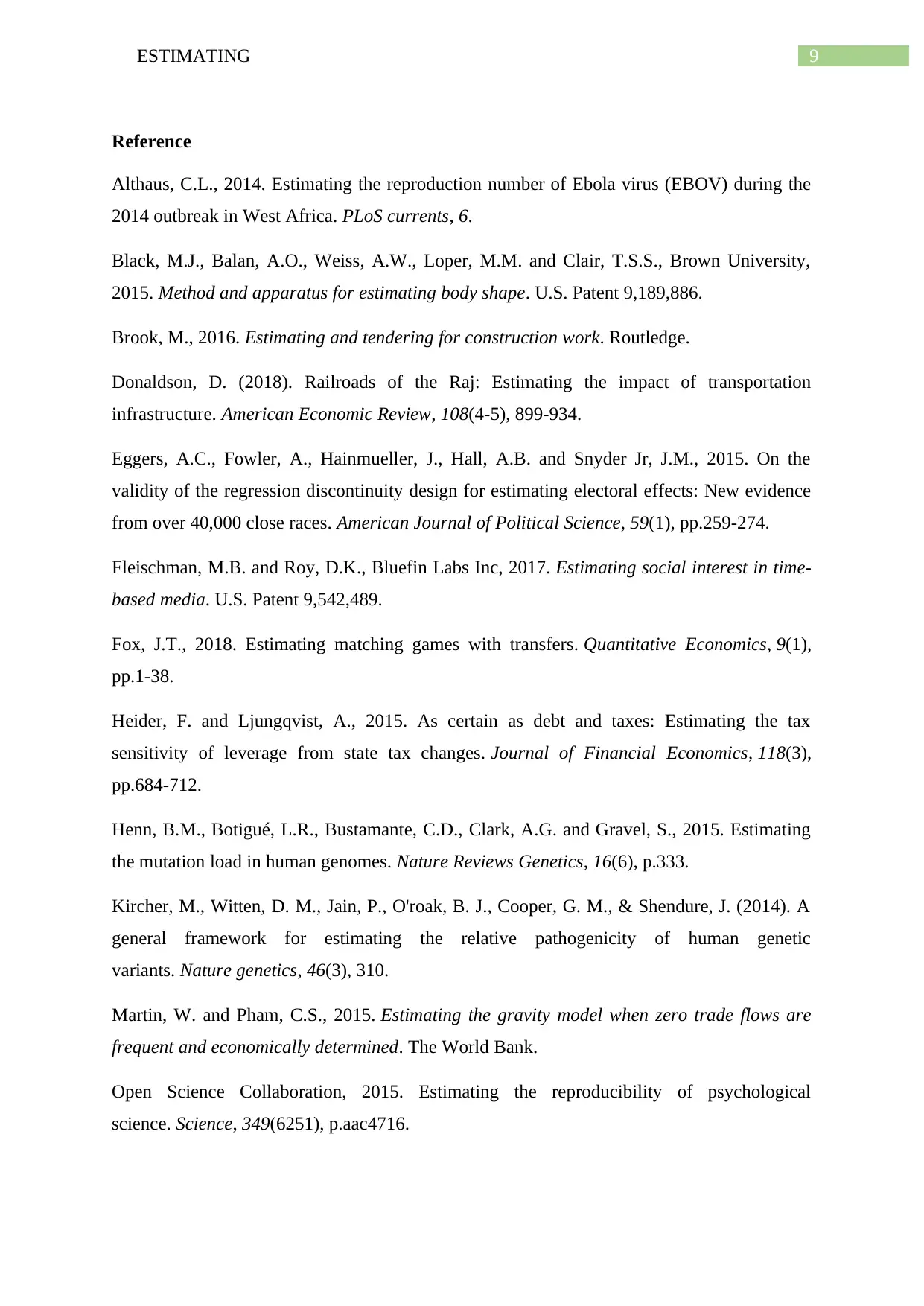
9ESTIMATING
Reference
Althaus, C.L., 2014. Estimating the reproduction number of Ebola virus (EBOV) during the
2014 outbreak in West Africa. PLoS currents, 6.
Black, M.J., Balan, A.O., Weiss, A.W., Loper, M.M. and Clair, T.S.S., Brown University,
2015. Method and apparatus for estimating body shape. U.S. Patent 9,189,886.
Brook, M., 2016. Estimating and tendering for construction work. Routledge.
Donaldson, D. (2018). Railroads of the Raj: Estimating the impact of transportation
infrastructure. American Economic Review, 108(4-5), 899-934.
Eggers, A.C., Fowler, A., Hainmueller, J., Hall, A.B. and Snyder Jr, J.M., 2015. On the
validity of the regression discontinuity design for estimating electoral effects: New evidence
from over 40,000 close races. American Journal of Political Science, 59(1), pp.259-274.
Fleischman, M.B. and Roy, D.K., Bluefin Labs Inc, 2017. Estimating social interest in time-
based media. U.S. Patent 9,542,489.
Fox, J.T., 2018. Estimating matching games with transfers. Quantitative Economics, 9(1),
pp.1-38.
Heider, F. and Ljungqvist, A., 2015. As certain as debt and taxes: Estimating the tax
sensitivity of leverage from state tax changes. Journal of Financial Economics, 118(3),
pp.684-712.
Henn, B.M., Botigué, L.R., Bustamante, C.D., Clark, A.G. and Gravel, S., 2015. Estimating
the mutation load in human genomes. Nature Reviews Genetics, 16(6), p.333.
Kircher, M., Witten, D. M., Jain, P., O'roak, B. J., Cooper, G. M., & Shendure, J. (2014). A
general framework for estimating the relative pathogenicity of human genetic
variants. Nature genetics, 46(3), 310.
Martin, W. and Pham, C.S., 2015. Estimating the gravity model when zero trade flows are
frequent and economically determined. The World Bank.
Open Science Collaboration, 2015. Estimating the reproducibility of psychological
science. Science, 349(6251), p.aac4716.
Reference
Althaus, C.L., 2014. Estimating the reproduction number of Ebola virus (EBOV) during the
2014 outbreak in West Africa. PLoS currents, 6.
Black, M.J., Balan, A.O., Weiss, A.W., Loper, M.M. and Clair, T.S.S., Brown University,
2015. Method and apparatus for estimating body shape. U.S. Patent 9,189,886.
Brook, M., 2016. Estimating and tendering for construction work. Routledge.
Donaldson, D. (2018). Railroads of the Raj: Estimating the impact of transportation
infrastructure. American Economic Review, 108(4-5), 899-934.
Eggers, A.C., Fowler, A., Hainmueller, J., Hall, A.B. and Snyder Jr, J.M., 2015. On the
validity of the regression discontinuity design for estimating electoral effects: New evidence
from over 40,000 close races. American Journal of Political Science, 59(1), pp.259-274.
Fleischman, M.B. and Roy, D.K., Bluefin Labs Inc, 2017. Estimating social interest in time-
based media. U.S. Patent 9,542,489.
Fox, J.T., 2018. Estimating matching games with transfers. Quantitative Economics, 9(1),
pp.1-38.
Heider, F. and Ljungqvist, A., 2015. As certain as debt and taxes: Estimating the tax
sensitivity of leverage from state tax changes. Journal of Financial Economics, 118(3),
pp.684-712.
Henn, B.M., Botigué, L.R., Bustamante, C.D., Clark, A.G. and Gravel, S., 2015. Estimating
the mutation load in human genomes. Nature Reviews Genetics, 16(6), p.333.
Kircher, M., Witten, D. M., Jain, P., O'roak, B. J., Cooper, G. M., & Shendure, J. (2014). A
general framework for estimating the relative pathogenicity of human genetic
variants. Nature genetics, 46(3), 310.
Martin, W. and Pham, C.S., 2015. Estimating the gravity model when zero trade flows are
frequent and economically determined. The World Bank.
Open Science Collaboration, 2015. Estimating the reproducibility of psychological
science. Science, 349(6251), p.aac4716.
Paraphrase This Document
Need a fresh take? Get an instant paraphrase of this document with our AI Paraphraser
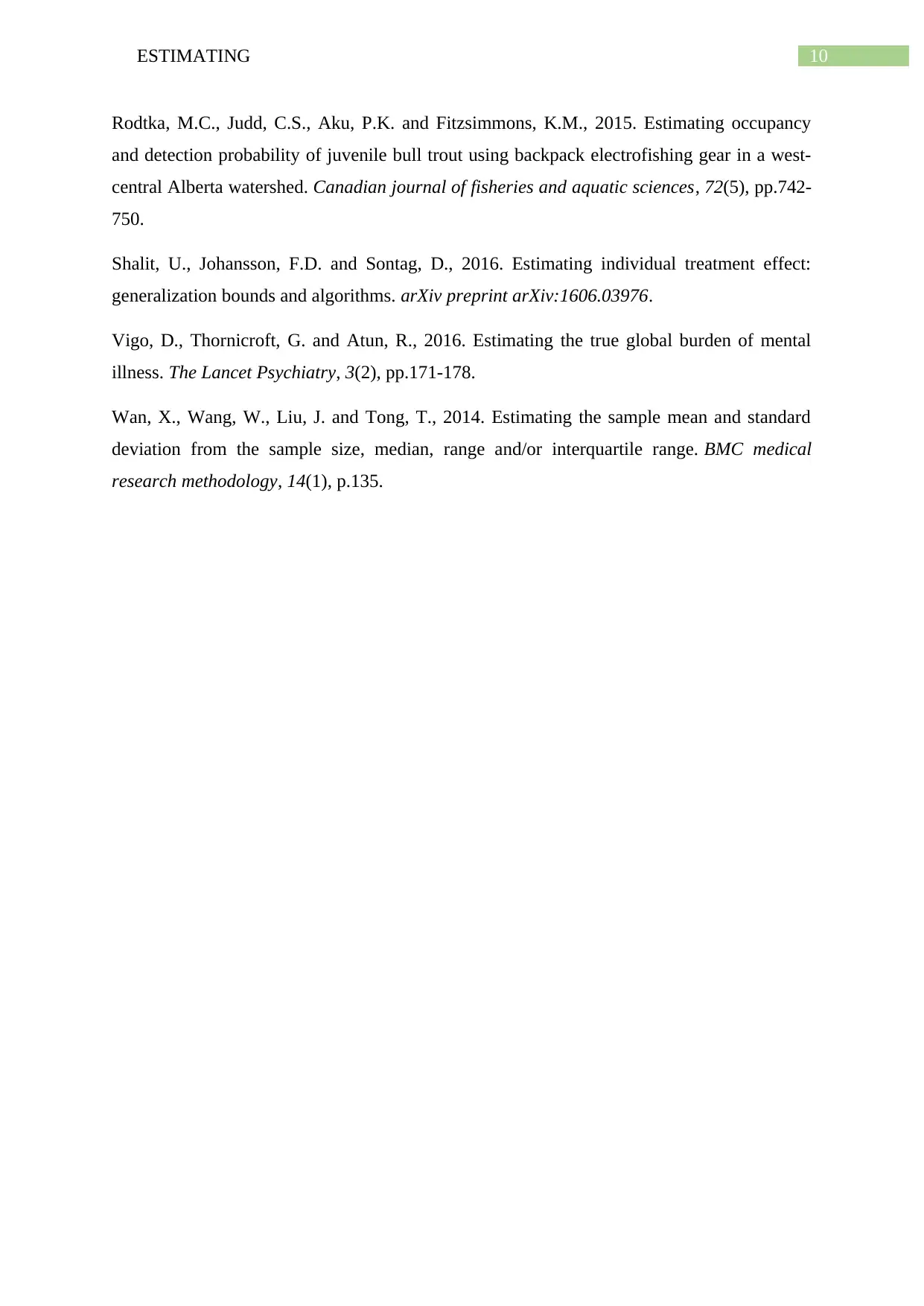
10ESTIMATING
Rodtka, M.C., Judd, C.S., Aku, P.K. and Fitzsimmons, K.M., 2015. Estimating occupancy
and detection probability of juvenile bull trout using backpack electrofishing gear in a west-
central Alberta watershed. Canadian journal of fisheries and aquatic sciences, 72(5), pp.742-
750.
Shalit, U., Johansson, F.D. and Sontag, D., 2016. Estimating individual treatment effect:
generalization bounds and algorithms. arXiv preprint arXiv:1606.03976.
Vigo, D., Thornicroft, G. and Atun, R., 2016. Estimating the true global burden of mental
illness. The Lancet Psychiatry, 3(2), pp.171-178.
Wan, X., Wang, W., Liu, J. and Tong, T., 2014. Estimating the sample mean and standard
deviation from the sample size, median, range and/or interquartile range. BMC medical
research methodology, 14(1), p.135.
Rodtka, M.C., Judd, C.S., Aku, P.K. and Fitzsimmons, K.M., 2015. Estimating occupancy
and detection probability of juvenile bull trout using backpack electrofishing gear in a west-
central Alberta watershed. Canadian journal of fisheries and aquatic sciences, 72(5), pp.742-
750.
Shalit, U., Johansson, F.D. and Sontag, D., 2016. Estimating individual treatment effect:
generalization bounds and algorithms. arXiv preprint arXiv:1606.03976.
Vigo, D., Thornicroft, G. and Atun, R., 2016. Estimating the true global burden of mental
illness. The Lancet Psychiatry, 3(2), pp.171-178.
Wan, X., Wang, W., Liu, J. and Tong, T., 2014. Estimating the sample mean and standard
deviation from the sample size, median, range and/or interquartile range. BMC medical
research methodology, 14(1), p.135.
1 out of 11
Related Documents
Your All-in-One AI-Powered Toolkit for Academic Success.
+13062052269
info@desklib.com
Available 24*7 on WhatsApp / Email
![[object Object]](/_next/static/media/star-bottom.7253800d.svg)
Unlock your academic potential
Copyright © 2020–2025 A2Z Services. All Rights Reserved. Developed and managed by ZUCOL.





